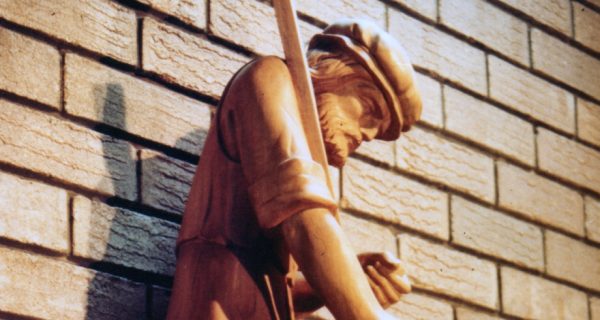In Elizabethan England it was against the law to practice the Catholic faith. Priests and sympathisers were arrested and treated brutally. Many died terrible deaths for their faith. Ingenious craftsmen were required to design and construct secret spaces to hide a priest and his ‘massing-stuff.’ These secret places were built in fireplaces, attics and staircases and were largely constructed between the 1550s and the time of the Gunpowder Plot in 1605. Sometimes other building alterations would be made at the same time as the priest’s holes so as not to arouse suspicion. The priest hole or hide, was usually tiny, with no room to stand up or move around. During a raid the priest would have to stay as still and silent as possible, for days at a time if necessary. Food, drink and basic sanitation had to be provided in these hiding places. During the reign of Elizabeth I, Jesuit priests were feared as enemies of the state and hunted down by agents of the Privy Council and by magistrates and pursuivants. Catholic priests moved from Catholic household to Catholic household, often pretending to be tutors, visitors or distant relations. Wealthy families built hiding places in their homes so that when the priest hunters came calling there was somewhere to hide their secret guest. Many manor houses employed mainly Catholic servants and retainers in order to protect the priests and the families. It was not unknown for disloyal servants to denounce their masters.
The authorities began to launch unannounced raids on the homes of known Catholic sympathisers. This often involved the priest-hunters known as pursuivants measuring the footprint of the house from the outside and the inside to see if they tallied; they would count the windows outside and again from the inside; they would tap on the walls to see if they were hollow and they would tear up floorboards to search underneath. Another tactic would be for the pursuivants to pretend to leave or quickly return and see if the priest would then emerge from his hiding place. Once detected and captured, priests could expect to be imprisoned, tortured, and put to death.
One of the priests who was arrested near Oxford was Fr Edmund Campion who is now a saint. At the time, one of Campion’s servants, an Oxford born carpenter and joiner who abandoned his apprenticeship to follow Campion was present at his arrest according to Mattias Tanner in his book on Jesuit martyrs published in 1675. (Reynolds, T, St Nicholas Owen, Gracewing 2014, p25) Whether or not this is accurate, what we do know is that Nicholas Owen, who joined the Society of Jesus, the Jesuits, as a lay brother, went on to construct the best examples of priest hides in England. It is impossible to know how many priest hides were constructed and where they were all located as, at the time, it was highly secret information. We know that some hiding places in the English midlands have been attributed to Nicholas Owen, who devoted the greater part of his life to constructing these places to protect the lives of persecuted priests. With incomparable skill Owen knew how to conduct priests to a place of safety along secret passages, to hide them between walls and in hidden recesses. With great ingenuity, he so disguised the entrances to these as to make them most unlike what they really were. Unsurprisingly, he kept these places so close a secret that he would never disclose to another the place of concealment of any Catholic let alone an agent of the crown. He alone was both their architect and their builder, and their location was secret. One thing is certain, Owen’s skilfully crafted priest holes saved many lives during this period of religious turmoil and persecution.
Owen was born in Oxford in 1562, one of four sons of Walter Owen. Their father was a carpenter and Nicholas followed him into the trade. In 1577, Nicholas Owen was apprenticed to the Oxford joiner William Conway and learned the skills that he later put to use designing and building secret hiding places. His brother John became a priest, his brother Walter died in 1591 and third brother, Henry, was apprenticed to a printer and engaged in the secret printing of Catholic literature. By the time he was in his mid-twenties, after the arrest and death of Fr Camion, he had apparently abandoned his apprenticeship as a joiner and taken up working for Father Henry Garnet, a well-known Catholic priest. He had also been accepted as a lay brother in the Jesuit order by then. Owen was a short man who was said to have suffered from ill health including a limp from a poorly set bone and a hernia. Despite his physical disabilities, he secretly travelled from manor house to manor house constructing priest holes throughout the midlands and beyond. He used pseudonyms such as Little John and few knew his real identity. His modus operandi was to work entirely on his own by candlelight at night to create his hiding places. Many of the priest holes were so well concealed that they were only discovered much later.
Owen’s favoured locations appear to have been behind fireplaces and under stairs. The pursuivants were men who could judge if an interior wall looked shorter than an exterior wall, so Owen had to be very careful as to where he located his priest holes. Sometimes he created a secret space which could be quickly found but was not the real hiding place for a priest.
By 1588, he was in the employment of the Jesuit priest, Fr Henry Garnet and Owen later himself became a Jesuit lay brother. He travelled from house to house, accepting only a bed and food as reward for his work and in a letter dated 1596, Father Garnet speaks of, “a carpenter of singular faithfulness and skill who has travelled through almost the entire kingdom and, without charge, has made for Catholic priests hiding places where they might shelter the fury of heretical searchers”. (Letter dated 1596 by Fr Henry Garnet)
The work of ‘Little John’ is particularly impressive when one considers that he was of diminutive size and walked with a limp after his leg was badly set following a fracture when a horse fell on him. He also had a hernia, but none of this prevented him from working alone and in secret, usually during the night, to break down stone walls and reconstruct them in such a way as to create secret places that were almost impossible to find if you did not know where to look. He made false entrances in fireplaces and staircases, trap doors, sliding doors and in one case at Speke Hall, near Liverpool, a crawl space above a ceiling accessed by a rope ladder in a small space at the side of a bedroom. He is said to have favoured sites away from outside walls and seems to have had the ability to think in three dimensions and in curves. Owen’s favoured locations seem to have been behind fireplaces and under stairs. In order to provide cover for his principal work of constructing priest-holes, Owen would always engage himself with other obvious works by day, only conducting the real work by night. This in itself must have been exhausting, not to mention that he would generally work unaided and would be engaged in substantial physical work. Whilst the hides built by others were often simple trapdoors or hidden doors, covered with furnishings or other floor coverings, Owen’s constructions are recognised because of the ingenuity of their construction.
Alan Fea’s book Secret Chambers and Hiding Places quotes an authority saying of his work, “With incomparable skill, he knew how to conduct priests to a place of safety along subterranean passages, to hide them between walls and bury them in impenetrable recesses, and to entangle them in labyrinths and a thousand windings.” Furthermore, Owen’s hides were always different, discovering one in one house would not help a searcher to find a hide in another house.
The pursuivants employed craftsmen who could judge if an interior wall looked shorter than an exterior wall, so Owen had to be very careful as to where he located his priest holes. He used false perspectives and illusion, now more often employed by stage magicians, to hide the priest holes. Some priests were discovered and arrested, but many more escaped detection thanks to his ingenuity and skills. The hiding places at Harvington Hall in Worcestershire are the finest surviving examples in England, and four of them, all sited round the Great Staircase, show the trademarks of Owen, the master builder. He was known to have stayed there around 1588. Baddesley Clinton in Warwickshire was a safe house for Catholic priests and home of the Jesuit priest Henry Garnet for almost 14 years. It too boasts several priest holes built by Nicholas Owen. One hiding place, just 3’ 9” high (114cm), is in the roof space above a closet off a bedroom. Another is in the corner of the kitchen where visitors to the house today can see through to the medieval drain where Father Garnet was hidden. Access to this hiding place was through the garderobe shaft in the floor of the room above. A hiding space beneath the library floor was accessed through the fireplace in the Great Parlour. They were sometimes built as an offshoot from a chimney. Another favourite entrance was behind panelling such as at Ripley Castle in North Yorkshire. Others were adapted from garderobes for example at Chesterton Hall, near Cambridge. Other places where known examples of his priest holes were at Oxburgh Hall, Norfolk, Coughton Court and Baddesley Clinton, both in Warwickshire. At Hoghton Tower, in Lancashire, one priest hole was only discovered when an electrician fell into it, and at Astley Hall, Chorley in Lancashire a priest hole was discover as recently as 2004. There is evidence that Owen also stayed at Sawston Hall and Huddington Court in Worcestershire.
Nicholas Owen is also credited with planning the daring escape of Fr John Gerard and another Catholic, John Arden from the Tower of London in 1597. They were being held in one of the towers but by means of bribery and cunning they were able to meet up. The plan was to rescue them from the roof of the Cradle Tower by means of a rope strung across the moat from the roof of the tower. After a failed first attempt to manoeuvre a boat into position, the rescuers tried again the following night. Waiting again until they had been locked in the tower together, Gerard and Arden climbed onto the roof. Throwing down a weighted cord they raised up a rope that had been tied to it by the rescuers below. The plan had been to slide down the rope but the angle it made meant that instead the escapers had to pull themselves hand over hand along its length. Fr Gerard was later smuggled out of England and made his way to Rome where ended his days.
Owen once had had a very narrow escape at Stoke Poges while engaged in constructing priests’ holes at the Manor House. The house, like many such houses was secluded and surrounded by woods. But this was not the only advantage. The walls were very thick and offered lots of opportunities for Owen. Whilst he was busily burrowing into the masonry a search party arrived; but somehow or other he slipped between their fingers and got away under cover of the surrounding woods.
The authorities continued to search for Catholic priests up and down the country. These searches could go on for many days and all the time the priest in his hidden chamber had to remain still and silent faced with either discovery or starvation. Surprisingly, there is no record of Harvington Hall ever having been searched. The centre of the operation for hiding priests in Worcestershire and the Welsh Marches was Hindlip Hall, the home of Humphrey’s friend Thomas Habington, where the Jesuit Edward Oldcorne arrived in 1590. Although Hindlip was demolished in 1814, descriptions of the hides there show a striking similarity to those that survive at Harvington. That is unlikely to be an accident. It was there that Garnet, Owen and Oldcorne were all captured in 1606, just after the Gunpowder Plot. According to Allan Fea (Secret Chambers and Hiding Places, Chapter 1) The walls of the mansion were literally riddled with secret chambers and passages. There was little fear of being run to earth with hidden exits everywhere, or so they must have thought. Wainscoting, solid brickwork, or stone hearth were used as possible places to hide a priest. Tensions were heightened as a result of the failed plot and the authorities were out to get as many Catholic sympathisers as they could. The house was surrounded by a hundred men at daybreak on Monday, the twentieth November and the searchers began to rip the house apart. Owen may have been starved out of his own hide on the fourth day of a twelve-day search, during which he and a companion, Ralph Ashley, had nothing to eat except one apple between them. They seem to have been discovered, creeping along a gallery, possibly to distract attention from the two priests, Fr Garnet and Fr Oldcorne, who were also in hiding there. But after eight days, the priests were found and also arrested. There would be no escape for Nicholas Owen. Fr Oldcorne and Ralph Ashley were later executed.
When he heard the news of Owen’s capture, Lord Cecil, the Secretary of State, wrote ‘Great joy was caused all through the kingdom by the arrest of Owen, knowing his skill in constructing hiding-places, and the innumerable number of these dark holes which he had schemed for hiding priests throughout the kingdom.’ (https://elizabethashworth.com/2015/05/13/nicholas-owen-builder-of-priest-holes/)
After his arrest Owen was transferred to the Tower of London and it was here he was tortured following Lord Cecil’s instructions that, ‘the secret is to be wrung from him’. Although it was illegal to torture disabled people, he was first manacled by the wrists and suspending in chains from a ceiling. This resulted in his hernia bulging from his body to such an extent that his intestines were protruding, so Topcliffe, the man tasked with his torture, ordered that an iron plate be strapped to him to hold them in. It was this plate that eventually killed him.. James I’s agents wanted to know everything he knew about the Recusant network of safe houses. He would not tell them. He told them what they already knew and that was all. According to the Jesuits in Britain website, we have two records of Owen’s confessions under torture. For example, on March 1, 1606: He confesses that he has known and sometimes attended Henry Garnett, the Provincial of the Jesuits for around four years. He confesses that he was at the house of Thomas Throgmorton called Coughton at the beginning of November last year, when the Lady Digby was there and by the watch that was in town they knew that Robert Catesby, Thomas Percy, and the rest of the gunpowder plotters were up in arms. That on All Saints Day last year, Garnett said Mass at Coughton House, and that at that Mass there were around half a dozen people. That Henry Garnett was at Henlipp, the house of Thomas Abington some six weeks before he was apprehended and Hall the Jesuit was there about three days before the house of Mr Abington was searched. (https://www.jesuit.org.uk/search/Nicholas%20owen)
Refusing to divulge any information he was racked and the result was that the plate cut into the hernia and ruptured it causing him to bleed to death in his cell in the early hours of second of March 1606. He took his knowledge of his priest hides to the grave, having divulged nothing to his torturers. The official stance was that he had committed suicide by ripping himself open with the knife given him to eat his meat. It is an unlikely story as the torture had left him unable to use his hands at all and suicide, for a Catholic, was a mortal sin that would have endangered his soul. Since they had learned nothing from Owen and had killed him, the authorities covered up what they had done by holding an inquest and issuing the verdict that Nicholas Owen had killed himself.
One can note the irony in trying to excuse the futile death of a man committed to the truth with a lie. As Father John Gerard later commented in his Autobiography, they added, “calumny to murder,” and that they had tortured him cruelly. Gerard comments that if Owen had not injured his neighbour by revealing secrets that would harm them, he certainly would not “offend God by self-murder” concluding that the “Day of Judgment will refute this calumny as well as others.” (Gerrard, J, Autobiography of a Hunted Priest)
He was buried in the grounds of the Tower of London. Fr Gerard said of him ‘I verily think no man can be said to have done more good of all those who laboured in the English vineyard. He was the immediate occasion of saving the lives of many hundreds of persons, both ecclesiastical and secular.’ It is true that many priests must have owed him their lives and many Catholic families were able to receive the sacraments from a priest because of his work. He was beatified by Pope Pius XI in 1929 and canonized by Paul VI as one of the Forty Martyrs of England and Wales in 1970. His Feast is celebrated on the 23rd January in the Diocese of Birmingham and 22nd March elsewhere and there is a church dedicated to him in Lancashire. In one of the odd twists of time, that many of the houses in which St. Nicholas Owen built priest holes are now tourist or pilgrimage sites such as Oxburgh Hall in Norfolk, Speke Hall near Liverpool, Baddesley Clinton and Harvington Hall in the midlands. Visitors can actually crawl into priest holes and see how it would have felt. From a place of desperate refuge, it has become a highlight on a day trip or pilgrimage. Next time you are visiting a Tudor house and you are shown a priest hole, spare a thought for Nicholas Owen for his ingenious work and for his horrific and painful death for his steadfast faith. Fr Garnet, a priest he worked for, said of him: “I verily think no man can be said to have done more good of all those who laboured in the English vineyard. He was the immediate occasion of saving the lives of many hundreds of persons, both ecclesiastical and secular.” (https://www.jesuit.org.uk/profile/nicholas-owen-sj)
Figures
Figure 1 Cross section diagram of Harvington Hall showing location of priest holes.

Figure 2 Location of a priest hole under the stairs at Harvington Hall.
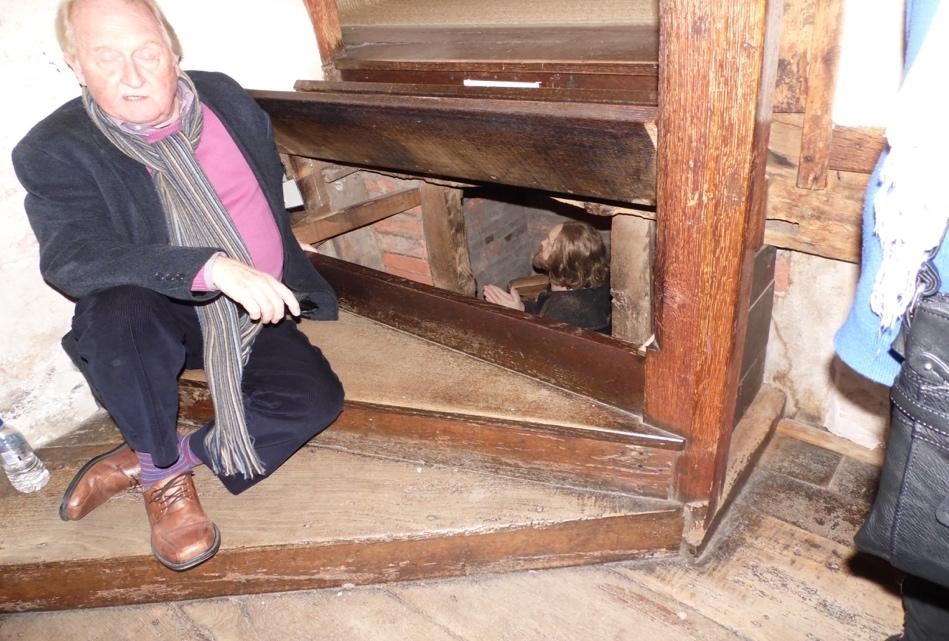
Figure 3 Cross section of Baddesley Clinton showing location of a priest hole in the sewer.
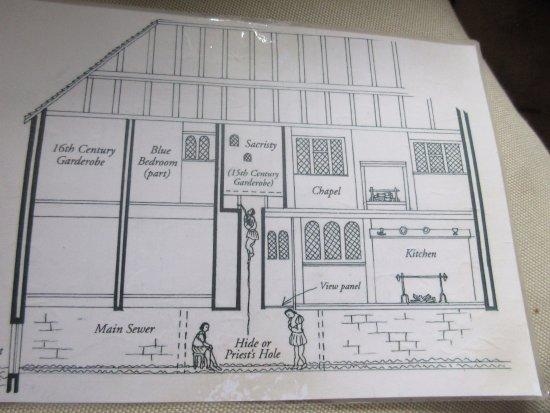
Figure 4 Entrance to priest hole at Baddesley Clinton.
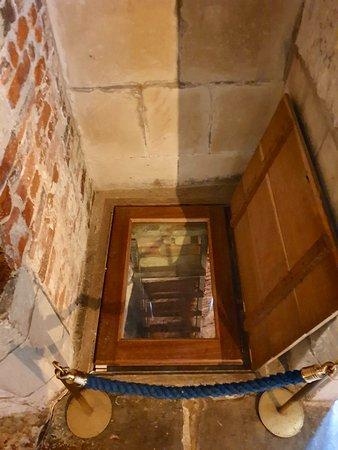
Figure 5 Entrance to a priest hole at Oxburgh Hall.
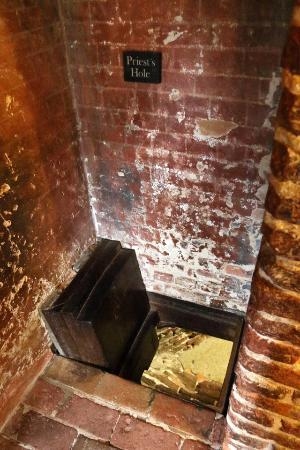
Figure 6 Entrance to a priest hole in the tower at Coughton Court.
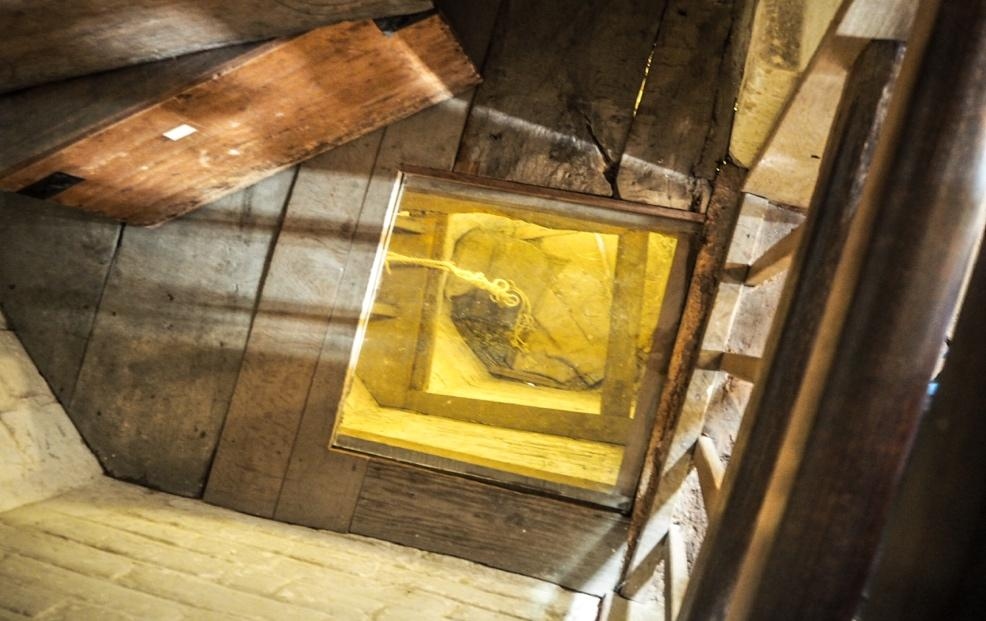
Figure 7 Hindlip Hall
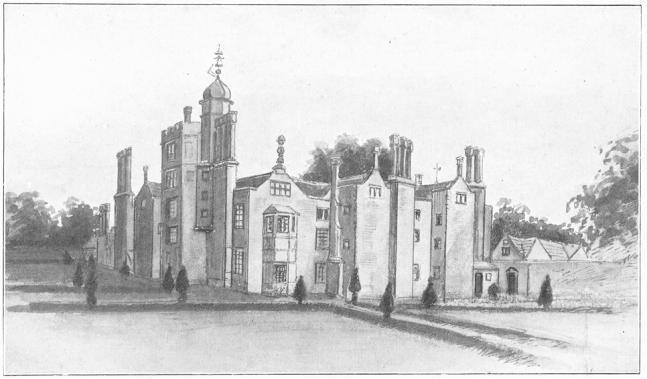
Figure 8 The torture of St Nicholas Owen
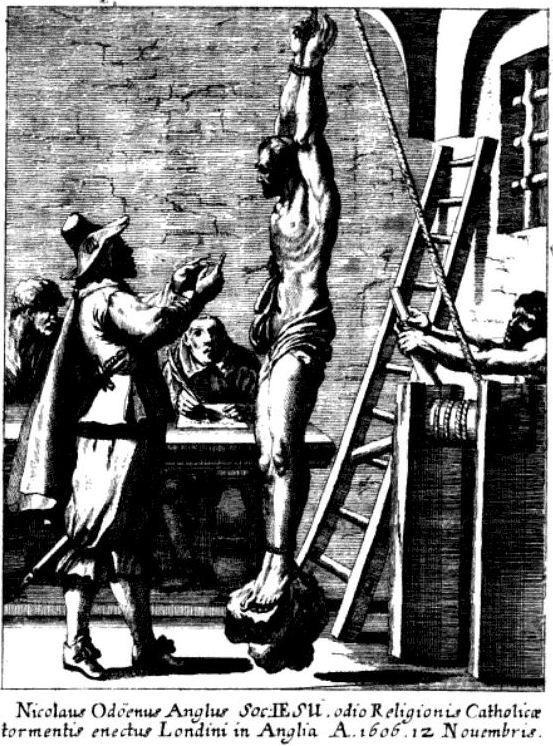
Bibliography and Sources
Childs, J, God’s Traitors, Penguin Random House, London, 2015
Fea, Allan, Secret Chambers and Hiding Places, Project Gutenberg, 2004
Fraser, A, The Gunpowder Plot, Phoenix, London, 1996
Gerrard, J, Autobiography of a Hunted Priest, Ignatius Press, San Francisco, 2012
Haward, W I, Hide or Hang: Priest Holes of North East England , Dalesman Publishing, Skipton 1966
Reynolds, T, Nicholas Own Priest-Hole Maker, Gracewing, Leominster 2014
Websites
https://www.nationaltrust.org.uk/lists/priest-holes
https://www.jesuit.org.uk/profile/nicholas-owen-sj
https://www.youtube.com/watch?v=SMktGl0W7pI
https://www.harvingtonhall.co.uk/the-priest-hides/
https://www.atlasobscura.com/articles/the-secret-rooms-that-were-custom-built-to-hide-your-priest
https://www.historic-uk.com/HistoryUK/HistoryofEngland/Priests-Holes/
https://thehistoryjar.com/2019/07/13/the-man-who-made-priest-holes/
https://www.storiesofanunschoolingfamily.com/priest-holes-persecution-and-catholic/
Priest Holes and Plotting at Hindlip Hall

